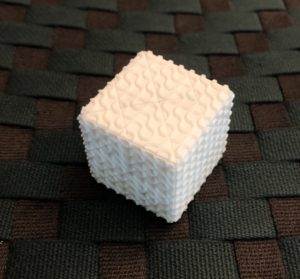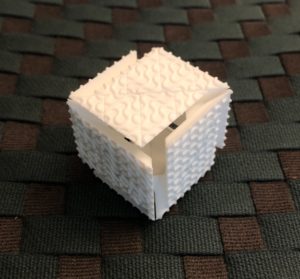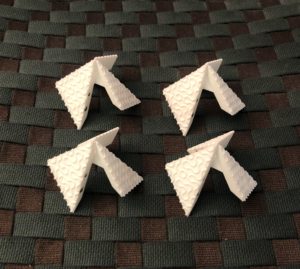I continue to be intrigued (obsessed?) with coordinate motion (como) puzzles and came across a really clever design of James Dalgety’s. He is one of the living legends in the puzzle design community and is well known for having started Pentangle Puzzles & Games in 1971 and more recently for curating the Puzzle Museum, an immense collection of puzzles dating back to 320 BC. Here is a paper he submitted to the 11th “Gathering for Gardner” conference in 2014 where he talks about about some of the puzzles he created for Pentangle, including “Looney Module” which is the topic of this post.
Although designed in 1974, “Looney Module” wasn’t manufactured until 1989 when it served as an exchange gift for that year’s International Puzzle Party (IPP) and it was never mass produced. I saw some pictures of it and was immediately interested in it because a) it is a four-piece coordinate motion puzzle and b) it’s shaped like a cube. That combination makes for a very tricky puzzle because no two faces will move directly away from each other and yet in a cube, that’s the motion one tends to look for.
So I fired up OpenSCAD, modeled it, 3D printed it, and started playing around with it. As with almost all como puzzles, spinning it is a pretty reliable way to open it but it’s also kind of risky as pieces may get lost or broken when they go flying all over the place. So I tweaked the design and added some magnets that stop the puzzle from fully disassembling (although if you really spin it hard, then yes, you can successfully lose or break some of the pieces). In the semi-disassembled stated, you can then pull the pieces away from each other for complete disassembly. Here are some pictures:



I was very pleased with how it came out. You can nonchalantly toss it up in the air with a little spin and it lands back in your hand part-way open. There is virtually no other way to open it since there is nothing on the outside to get a grip or even a fingernail hold on. Well, I suppose you could spin it on a table, sure, but that has no panache, no style, no flair. Anyhow, I am happy to report that James has given me permission to sell this remake of his design and you can find it on my Etsy store.
Now, remember that paper I mentioned above that James had contributed to the 11th Gathering for Gardner conference? Well, a different paper by George Bell submitted for the same event briefly mentions his “Dice Box” puzzle. Although “Dice Box” is a cubical puzzle, George evolved it from a 2013 rhombic dodecahedron puzzle by Stuart Gee and Stephen Chin. Despite having been developed over two decades apart and from completely different initial concepts, “Looney Module” and “Dice Box” have the same internal mechanism. It’s pretty clear the universe really wants a cubical four-piece como puzzle to exist and I’m happy to oblige.
The George Bell paper is titled “The Pennyhedron Revisited”. It is a wonderfully thorough review and exploration of rhombic dodecahedron dissections and is well worth reading. Best of all, some of the dissections yield coordinate motion assembly/disassembly (woot!) I have more to report on that but will save it for another post.
